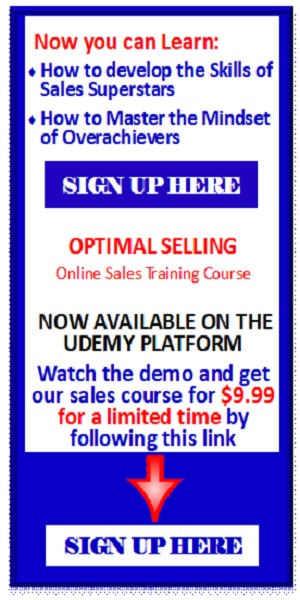 Weasel words are the downfall of many sales pursuits. Prospects tend to use vague, non-specific, positive sounding words to keep you excited and interested in giving them what they need. What they need is to pick your brain and get more information or to keep you in the game because they need three bidders to run a competition. Many times they do this when they really have no intention of buying from you. Maybe they don’t have the money or they favor the competition. Or on less jaded view, maybe they don’t want to hurt your feelings or they want to let you down easy or they think it is somehow helpful to you to keep you in the game with hope when there really is none. In either case, you need to identify these words and ask questions to determine if they are really positive or just leading you on.
Weasel words are the downfall of many sales pursuits. Prospects tend to use vague, non-specific, positive sounding words to keep you excited and interested in giving them what they need. What they need is to pick your brain and get more information or to keep you in the game because they need three bidders to run a competition. Many times they do this when they really have no intention of buying from you. Maybe they don’t have the money or they favor the competition. Or on less jaded view, maybe they don’t want to hurt your feelings or they want to let you down easy or they think it is somehow helpful to you to keep you in the game with hope when there really is none. In either case, you need to identify these words and ask questions to determine if they are really positive or just leading you on.
Beware of weasel words
Objections are a symptom
Video Length: 1:27 minutes.
 Skipping steps in the sales process leads to the prospect raising objections. Most salespeople spend too much time handling objections needlessly. If you skip steps in your sales process the prospect will raise questions at the end you can count on it. Don’t gloss over topics that you know will be an issue in hope that it won’t matter to this prospect. If there are frequent objections that you hear, you should raise the issue before the prospect does you will be better able to handle it than if you wait until they bring up. Sometimes the sales process moves quicker due to the urgency on the part of the prospect. But no matter how quickly it moves you still have to “touch all the bases”. In other words, don’t short change the money step just because the prospect says money is no object. Don’t short cut the discussion of the decision process just because the prospect is in a hurry and you want to move to the close. If you do, you will most likely have to deal with objections somewhere down the line.
Skipping steps in the sales process leads to the prospect raising objections. Most salespeople spend too much time handling objections needlessly. If you skip steps in your sales process the prospect will raise questions at the end you can count on it. Don’t gloss over topics that you know will be an issue in hope that it won’t matter to this prospect. If there are frequent objections that you hear, you should raise the issue before the prospect does you will be better able to handle it than if you wait until they bring up. Sometimes the sales process moves quicker due to the urgency on the part of the prospect. But no matter how quickly it moves you still have to “touch all the bases”. In other words, don’t short change the money step just because the prospect says money is no object. Don’t short cut the discussion of the decision process just because the prospect is in a hurry and you want to move to the close. If you do, you will most likely have to deal with objections somewhere down the line.
Determine the Urgency
 Sales can be derailed and forecasts rendered inaccurate when you fail to nail down the urgency. Remember that urgency involves a time component.
Sales can be derailed and forecasts rendered inaccurate when you fail to nail down the urgency. Remember that urgency involves a time component.
A prospect may not be happy at the current situation but is willing to live with it for the foreseeable future. The salesperson who only focuses on pain, and doesn’t deal with the time element, will forecast an imminent sale only to waste time chasing it for months.
WRITING PROPOSALS
 We believe that the prospect has to earn the right to get a proposal from the salesperson. The Optimal Salesperson® will only write a proposal to a prospect who has completely met all of the elements to be considered a qualified prospect. Most salespeople spend entirely too much time writing proposals. They do a cursory job of qualifying the prospect and then they either volunteer to write a proposal or are asked to write one which they eagerly agree to do. There are several possible factors which can cause this to happen.
We believe that the prospect has to earn the right to get a proposal from the salesperson. The Optimal Salesperson® will only write a proposal to a prospect who has completely met all of the elements to be considered a qualified prospect. Most salespeople spend entirely too much time writing proposals. They do a cursory job of qualifying the prospect and then they either volunteer to write a proposal or are asked to write one which they eagerly agree to do. There are several possible factors which can cause this to happen.
- The salesperson does not have or does not use and effective sales process
- The salesperson knows how to qualify a prospect but is unskilled at executing the process
- The salesperson has a belief that they must quote when asked
- The salesperson has a fear of rejection so they won’t ask the tough questions
- The salesperson believes that they can’t win if they don’t quote
- The salesperson thinks that writing proposals with low probability is a good way to avoid prospecting which they hate worse than writing proposals
There are many more possible reasons and some salespeople suffer from more than one.
ARE SALESPEOPLE BORN OR MADE?
 Some are born most are made. Born salespeople are as rare as painters like Monet and Picasso or basketball players like Michael Jordan and LeBron James or Tenors like Bocelli and Pavarotti. But even they did not emerge on the scene fully developed. Monet broke internal barriers and helped create the impressionist movement. Jordan spent hours in the gym and set a new standard of excellence on the court and Pavarotti took many voice lessons and practiced for hours to redefine what a powerful tenor should sound like. The difference between successful salespeople and the “also ran’s” is motivation to develop skills through consistent practice and the willingness to uncover hidden obstacles (like discomfort discussing money) and to put in the effort required to overcome the obstacle. You don’t have to be Jordan, Monet or Pavarotti to succeed. Anyone can do it if they are willing to put in the effort and get the right type of coaching to shorten the process.
Some are born most are made. Born salespeople are as rare as painters like Monet and Picasso or basketball players like Michael Jordan and LeBron James or Tenors like Bocelli and Pavarotti. But even they did not emerge on the scene fully developed. Monet broke internal barriers and helped create the impressionist movement. Jordan spent hours in the gym and set a new standard of excellence on the court and Pavarotti took many voice lessons and practiced for hours to redefine what a powerful tenor should sound like. The difference between successful salespeople and the “also ran’s” is motivation to develop skills through consistent practice and the willingness to uncover hidden obstacles (like discomfort discussing money) and to put in the effort required to overcome the obstacle. You don’t have to be Jordan, Monet or Pavarotti to succeed. Anyone can do it if they are willing to put in the effort and get the right type of coaching to shorten the process.
See it the prospect’s way
 Prospects have the right perspective on things. At least as far as they are concerned. And since they hold the purse strings, that is all that matters when it comes to making the sale. They may actually be totally wrong. But from their perspective, they are right. It is usually futile and (a losing sales practice) to try to logic them out of their perspective. A better strategy is to attempt to understand exactly how they see it, then ask them questions in such a way as to allow them to come to their own conclusion … the one that you want them to get to. That is the essence of consultative selling. It all starts with a mindset that it is imperative to “See it the prospect’s way”.
Prospects have the right perspective on things. At least as far as they are concerned. And since they hold the purse strings, that is all that matters when it comes to making the sale. They may actually be totally wrong. But from their perspective, they are right. It is usually futile and (a losing sales practice) to try to logic them out of their perspective. A better strategy is to attempt to understand exactly how they see it, then ask them questions in such a way as to allow them to come to their own conclusion … the one that you want them to get to. That is the essence of consultative selling. It all starts with a mindset that it is imperative to “See it the prospect’s way”.
AN EFFECTIVE SALES PROCESS
 Most sales processes being used in the field today are me-centered. Me-centered selling is when the salesperson spends most of the time with a prospect talking about the product being sold or the company selling it. Thus, when a salesperson starts to engage with a prospect, most often the prospect recognizes that he is being sold to, and immediately shuts down and gets defensive. We believe that me-centered selling is not only ineffective but it is offensive to the prospect. More importantly most people have a natural reluctance to self-promotion. Our belief is that the most effective and authentic sales process is prospect centered. The prospect doesn’t care about you or your company. They care about their own problem and their own situation. It is the job of the salesperson to focus on the prospect and through skillful yet honest and authentic conversation discover if the prospect actually has a compelling reason to buy and if so when, how, and for how much.
Most sales processes being used in the field today are me-centered. Me-centered selling is when the salesperson spends most of the time with a prospect talking about the product being sold or the company selling it. Thus, when a salesperson starts to engage with a prospect, most often the prospect recognizes that he is being sold to, and immediately shuts down and gets defensive. We believe that me-centered selling is not only ineffective but it is offensive to the prospect. More importantly most people have a natural reluctance to self-promotion. Our belief is that the most effective and authentic sales process is prospect centered. The prospect doesn’t care about you or your company. They care about their own problem and their own situation. It is the job of the salesperson to focus on the prospect and through skillful yet honest and authentic conversation discover if the prospect actually has a compelling reason to buy and if so when, how, and for how much.
ON WHAT IT TAKES TO SUCCEED IN SALES
 The two most important attributes of the successful salesperson are desire and commitment. Desire is the passion for success. In other words, it is the drive to achieve financial goals, or to be the best you can be. Desire most frequently manifests itself in the motivation to achieve specific financial objectives, but a better community, or lifestyle is often what defines success for a particular individual. Commitment is the willingness to do whatever it takes to get there. Not anything that is illegal or unethical or immoral or physically unsafe. But the willingness to face internal demons and get out of one’s comfort zone is what commitment is all about. Commitment is doing or saying what is necessary for success even when it is uncomfortable or scary for us to do so.
The two most important attributes of the successful salesperson are desire and commitment. Desire is the passion for success. In other words, it is the drive to achieve financial goals, or to be the best you can be. Desire most frequently manifests itself in the motivation to achieve specific financial objectives, but a better community, or lifestyle is often what defines success for a particular individual. Commitment is the willingness to do whatever it takes to get there. Not anything that is illegal or unethical or immoral or physically unsafe. But the willingness to face internal demons and get out of one’s comfort zone is what commitment is all about. Commitment is doing or saying what is necessary for success even when it is uncomfortable or scary for us to do so.
Earn More Money
 The amount of money your product or service can command is in direct proportion to the value it has as perceived by the prospect. The prospect will see it as having more value if it solves big (and expensive) problems. So to earn more money, solve bigger problems. Of course this requires you to focus on the prospect and their problems and not on your product … but that is a video sales tip for another day!
The amount of money your product or service can command is in direct proportion to the value it has as perceived by the prospect. The prospect will see it as having more value if it solves big (and expensive) problems. So to earn more money, solve bigger problems. Of course this requires you to focus on the prospect and their problems and not on your product … but that is a video sales tip for another day!
It’s a Conversation Not an Inquisition or and Interrogation
 I think probing questions should be left to Attorneys in a court room. Salespeople are often taught to ask probing questions. But who wants to be probed? Do You? I didn’t think so. Neither do your prospects. Steve Yastrow has it exactly right in his recent blog post. In it he states:
I think probing questions should be left to Attorneys in a court room. Salespeople are often taught to ask probing questions. But who wants to be probed? Do You? I didn’t think so. Neither do your prospects. Steve Yastrow has it exactly right in his recent blog post. In it he states:
“Questions are effective, but they are most effective in the context of a conversation. To Joe’s customers, these questions didn’t feel like a conversation. They felt like an interrogation.
Conversation is a key element of any relationship-building customer interaction. Customers will feel more comfortable if the questions you ask are integrated into a back-and-forth dialogue than if they come rapid-fire, one after another.”
He goes on to explain more about how to conduct the “conversation”. It is well worth the read. You can get the entire article here.

